How 3 Big Brands Went Hard Core With Content Marketing (And the Lessons You Can Learn From Their Success)
April 2013
By Jason Ferster
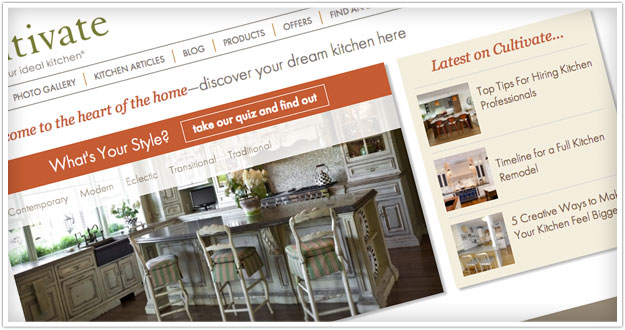
In spite of all the hype that surrounds content marketing these days, many businesses still have lingering questions about exactly how to use content as a viable marketing strategy:
- What exactly is content?
- How do I know if this approach is right for my business?
- What resources do I need?
- How do I measure the return on our investment?
- My company sells widgets, so why would we need it?
In the face of such uncertainty, it's human nature – and therefore the nature of business – to look to those around us for guidance and inspiration. This is especially true for brands that have earned our respect. We may not always have access to the carefully guarded data behind their decisions, but where and how those organizations invest their marketing dollars is telling.
So let’s look at how three top brands – a lifestyle products company, a professional services association and an e-commerce behemoth – are investing in content to build relationships with customers and drive sales.
Cooking up content with Williams-Sonoma
Known for its high-end kitchen products, Williams-Sonoma has crafted a customer experience that’s far different from buying discount cookware off the rack at big box stores. Instead, the company has built a lifestyle brand around the idea of just how rich life in the kitchen can be.
As a result, it's no surprise that Williams-Sonoma's website is well stocked with content about the food-lover lifestyle, including recipes, wine, entertaining ideas and gardening tips.
The brand, however, has taken content-as-marketing-strategy a giant leap further by developing a website dedicated solely to kitchen design and remodeling – Cultivate.com – with features like premium photo galleries for design inspiration and a database of remodeling professionals aimed at helping readers create their dream kitchens.
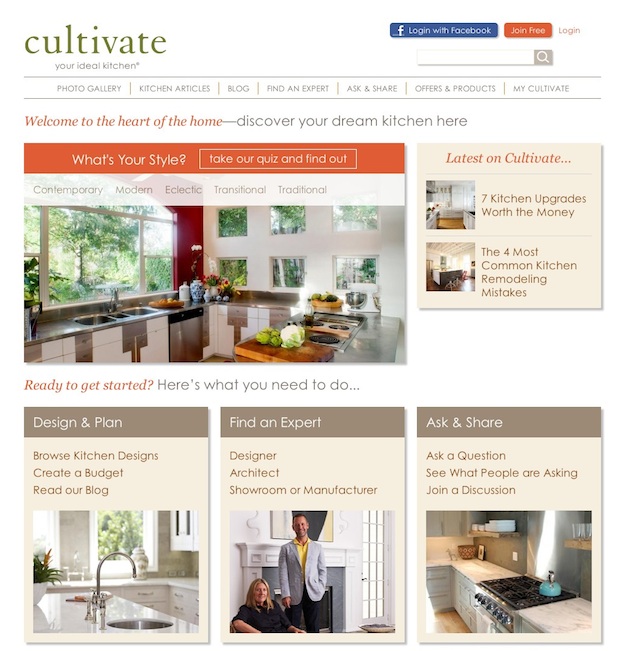
Cultivate content partnerships Williams-Sonoma style
With Cultivate, Williams-Sonoma has done something noteworthy by forming strategic partnerships with both premium brands and remodeling professionals. As a result, they've created both a high-quality remodeling resource for consumers and a powerful sales tool for business.
It's a win/win/win scenario.
First, Williams-Sonoma wins because these partners, incentivized to provide great content for the site, bring additional expertise and value to readers while simultaneously easing the resource burden of producing so much high quality content. Williams-Sonoma can equip your kitchen with gadgetry, but "A Shopper's Guide to White Marble Counters" is outside the brand's focus. Fortunately, premium tile company and Cultivate partner Walker Zanger has the expertise and credibility with customers to fill that content void.
Second, the partners win because William-Sonoma has created a micro-marketplace and platform for engaging with customers already primed for their products. The site's powerful photo gallery feature lets users search kitchen designs by color, layout, style and cost, and all of the content is professionally produced by design and architectural firms eager to feature their services.
Last and most importantly, readers win because they get a better resource for kitchen remodeling, with professionally written content, expert advice, special offers and carefully curated products – all in one convenient package.
Even if you don't have a Cultivate-sized budget, your business can still take advantage of content partnerships and the benefits they provide. The key is to identify other companies that compliment – not compete with – your products or services.
For example, a business law firm could partner with both a CPA and management consultancy to create an advice blog serving local business owners.
Or, as a starting point, consider having other businesses provide some guest posts for your company blog. This toe-in-the-water approach allows you to test how well their content resonates with customers and which potential cohorts are the right fit, all before diving into a content partnership.
Just like cooking, gardening and most other things in life, it's often wise to start small, learn from both your mistakes and your success, and then grow from there.
Content from REALTORS that really hits home
The National Association of REALTORS (NAR) has long positioned itself as the foremost authority on home ownership, and its impressive credentials back up that message. It's the largest trade association in the U.S. with over 1 million members and its own political action committee.
So it makes sense that its brand message to potential clients is that Realtors, as experts on everything from property values to legal issues, are essential to navigating the complexities of buying or selling a home.
The challenge when selling professional services, however, is that you are, according to best-selling marketing author Harry Beckwith, "selling the invisible." There's no product to return for a refund if the customer is dissatisfied, and the stakes are often higher, both in cost and risk. So building trust with your clientele before they sign a contract is critical.
NAR is using content to build this trust and reinforce the perception of its brand as a network of specialized experts through HouseLogic.com, an exhaustive information resource dedicated to all areas of homeownership, including:
- DIY home improvement and maintenance
- Working with contractors
- Outdoor and green living
- Understanding insurance, home financing and taxes
- Education about home ownership legislation and causes
- Working with a Realtor
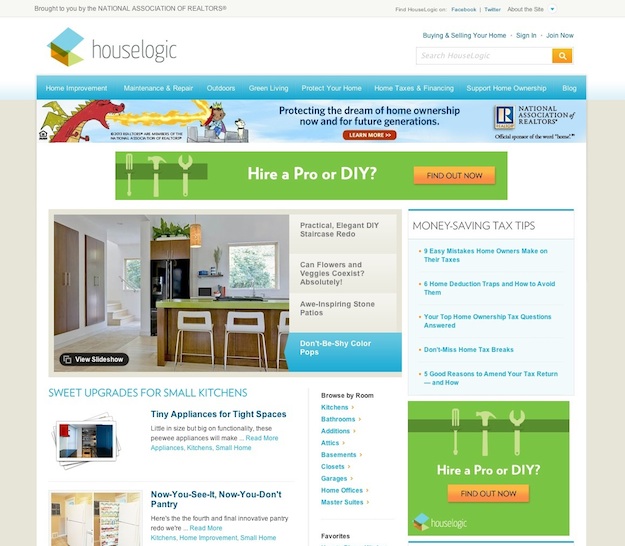
Want to gauge whether to tackle a home improvement project yourself or hire a contractor?
What's the difference between a standard home equity loan and an FHA 203(k) loan?
Who are Fannie Mae and Freddie Mac?
HouseLogic holds the answer. So what key content lessons does HouseLogic hold for the rest of us?
Build content the REALTOR way
First, build to your brand. HouseLogic draws visitors in with content about curb appeal and customized kitchens, but it doesn't stop there. Rather, it moves beyond these themes common to thousands of other sites and addresses issues more critical for homeowners – issues only the NAR could speak to. This depth and breadth reinforces the REALTOR brand as the definitive information resource for homeowners.
If you're a product company, create content that mirrors the space where your products intersect with your customers' lifestyles. If you provide services, make sure your content approach supports the emotions that you want customers to associate with your brand, whether trust, enjoyment, security or convenience.
Second, hire pros as much as possible. Realtors want you to rely on their professional expertise, so HouseLogic follows that thinking by using experienced content creators who are knowledgeable about the topics they're covering. For example:
One writer covering home decor and improvement, is a "HouseLogic contributor and builder of luxury homes in McLean, Va. She’s been a Homes editor for Gannett News Service and has reviewed home improvement products for AOL."
Another who writes about DIY repairs and remodeling, "has written or edited over 60 books on home repair and remodeling for The Home Depot, Lowe’s, Better Homes & Gardens, Sunset, and Reader’s Digest. He's a former contractor with decades of hands-on experience."
Your organization may not have NAR's resources, but that doesn't mean you shouldn't invest in creating as much great content as your budget allows. In these freelance-friendly times, there are writers and editors aplenty. Or save yourself the hassle and outsource your content entirely to a trusted digital marketing firm that understands the intersection of the Web, content and customer experience.
And don’t forget about photography and video production – two other content areas where it's typically better to hire a pro than to do it yourself. For some brands, a slick video may seem to sales-y while a more amateur style video could come across as more genuine.
Keep in mind, the main objective is not to simply to look professional but to build your reputation as an expert in your field, and hiring a professional can help you find that focus.
Content to cart with Amazon.com
While Amazon.com has built an e-tail empire hawking content such as books, movies and music, the brand's approach to connecting with customers through content is just as impressive.
Unlike Williams-Sonoma, NAR and probably 99 percent of other companies using content to grow their businesses, Amazon has chosen to buy rather than build, to purchase a stake in pre-existing communities and their rich content rather than producing their own. And boy have they picked winners.
IMDB.com (Internet Movie Database) is essentially the Wikipedia of film and television. The content is entirely created by the user community, covering cast lists, photos, trailer clips, script overviews, production notes, trivia, industry news and much more. It's the destination site for lovers of film and television.
Similarly, DPReview.com (Digital Photography Review) has been providing in-depth reviews of cameras and photography equipment for years, building a large and engaged community of pro and amateur photographers who share their questions and insights in forums and their photos in galleries.
It's not difficult to see why Amazon would want to tap into these content communities. Ads and obvious calls-to-action allow site visitors to easily move from an article about a movie or camera to the corresponding product page on Amazon.

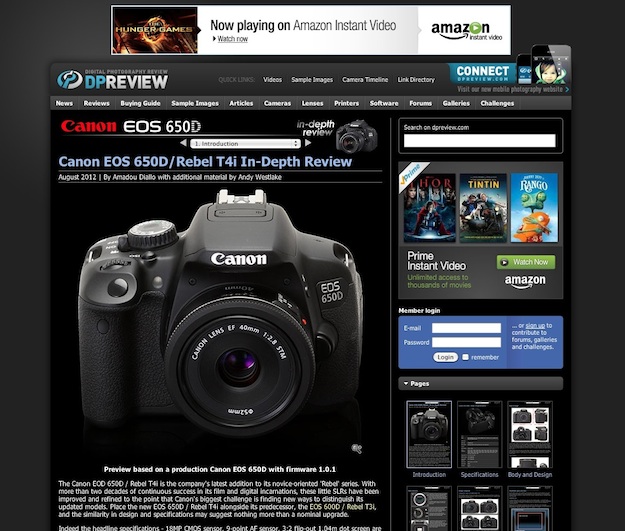
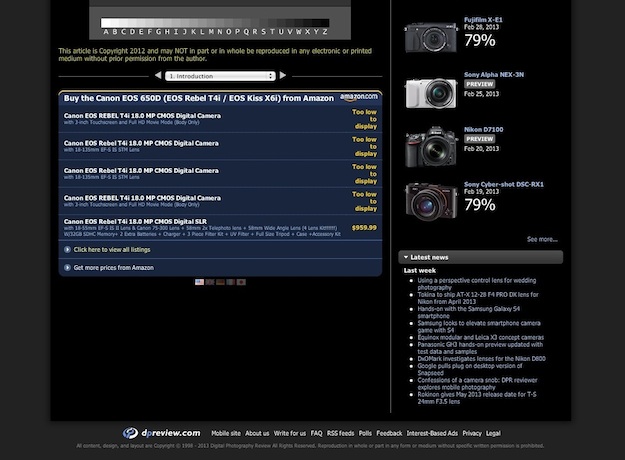
But Amazon has very impressively exercised much restraint here, choosing to be present in the content but not dominate it. In other words, Amazon didn't start meddling with what the community had built. To do so would have meant a breakdown of user trust and therefore site traffic and sales. They don't care which camera or movie you buy, as long as you're buying it from Amazon.
Connecting with content communities
Amazon is a trail-blazing company in many ways, and their decision to to plug in rather than publish on their own is a path worth considering, especially for organizations just starting out with content marketing.
You don't have to build a great content site if you can buy one that's already providing great content and has a loyal following. If that sounds too expensive, then look for a small but respected blog in your niche market to use as a test project.
If you can't buy at all, you can still make the most of other people's content by growing your own presence in their communities. Engage in forums and contribute content to their sites.
If you do buy a site, stay out of the way. DPReview's press release about being acquired by Amazon includes a reassuring "we-won't-break-it" quote from Amazon CEO Jeff Bezos: “DPReview.com is by far the most authoritative source anywhere for straight talk about new digital cameras. We at Amazon.com have been their fans for a long time, and we extend a big welcome to the dpreview.com team.” The release goes on to reassure everyone that the site "will continue to function as a stand-alone operation."
It will be tempting to try to bend the conversations and content in your favor and promote your products extensively, but such heavy handedness is a quick way to kill an online community. Don't ruin the trust that's already been created between the site and its followers.
These themes of building trust and providing value are the common threads that connect Amazon, the National Association of REALTORS, Williams-Sonoma and every other company that's doing content marketing well. It is without a doubt the most important lesson we can learn from their examples.
By day, Jason Ferster is the marketing manager of an IT consulting firm, where he contends daily with the marketing challenges common to small and mid-sized businesses. By nights and weekends, he writes about insights gained from those experiences. Visit FersterFiles.com for more or connect with Jason on Twitter.